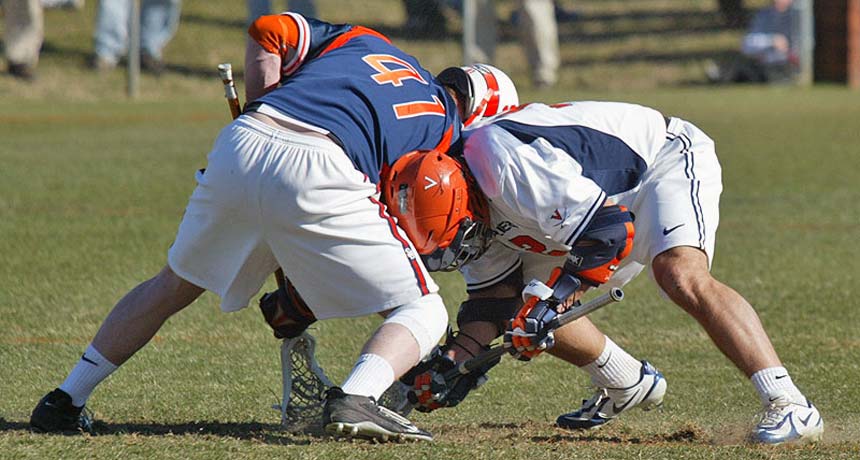Lacrosse: Different genders, same injuries
Scientists find boys and girls suffer similar lacrosse injuries

Boys’ lacrosse allows full body contact, which is why the guys must wear helmets. New data now indicate that girls playing the sport suffer enough head injury to warrant helmets as well.
popofatticus – Flickr/ Wikimedia Commons
In the fast-paced game of lacrosse, players zing a ball from crosse to crosse. (The crosse is a stick with a net on one end. Players use it to move the ball down the field.) When all goes well, the ball whizzes over opponents’ heads, past the goalie’s crosse and — whomp! — into the goal. Unfortunately, the athletes’ bodies all too often get whomped as well.
Over 170,000 U.S. boys and girls play lacrosse in high school. The sport has grown steadily more popular over the past five years. And along with that growth has come an increase in injuries.
A new study reveals that strains and sprains are the most common type. Concussions run a close second. That was true for both boys and girls playing lacrosse — despite differences in how they play the sport. The new findings appear July 22 in the American Journal of Sports Medicine.
Boys’ lacrosse is a full-contact sport. Players are allowed to body-check. That’s when one player slams his shoulder, arm or hip into another player. Because of the rough nature of the game, players wear a helmet, mouth guard, shoulder and arm pads, and padded gloves. In girls’ lacrosse, no such body contact is allowed. As a result, girls are required only to wear a mouth guard and protective eyewear.
Dawn Comstock and her colleagues wanted to find out how players were being injured. Comstock is an epidemiologist at the University of Colorado in Denver. (Like a detective, an epidemiologist figures out what causes a particular illness or injury.) The researchers analyzed data from the High School RIO (an acronym for Reporting Information Online). This website logs sports injuries. From 2008 to 2012, 1,406 lacrosse injuries were reported. Boys were injured more often than girls. Both were more likely to be injured during competition than practice. And concussions accounted for more than one in every five lacrosse injuries, regardless of gender.
Concussion occurs when the head rapidly snaps forward, back or to the side. This causes the brain to slam against the inside of the skull. The brain tissue also can twist. Such movement can damage not only the outer region of the brain but also the delicate connections deep within. Repeated concussions have been associated with balance, coordination and memory problems.
“This is an important study because it demonstrates that concussion is a frequent cause of injury in lacrosse, both among girls and boys,” says Frederick Rivara. He is a pediatrician at the University of Washington in Seattle and was not involved in the study. Rivara says the findings should be used to search for more protective equipment.
Comstock agrees that changes to protective equipment are needed. Body contact was the most common cause of concussion in boys, she points out. Girls, by contrast, were more likely to be concussed when hit by a crosse or ball.
That method of injury is exactly the type that could be prevented by a helmet, Comstock says. Such protective gear would help to prevent the sharp head movement that leads to concussions. It would work in the same manner as a construction worker’s hard-hat, she explains.
Requiring girls to wear helmets is a matter of debate within the lacrosse community, however. “People feel girls will play rougher if they wear helmets,” says Comstock. But she argues that aggressive player contact won’t increase if coaches continue to teach the existing rules — and if referees enforce them.
How well helmets would protect against concussion in girls’ lacrosse remains unknown. That’s because there are no helmet-wearing girl players available for comparison. But researchers are ready to find out. If teams begin to wear the protective equipment, those comparisons can be made. They also could spot any increase in injuries, should the players get rough.
Power Words
concussion Temporary unconsciousness, or headache, dizziness or forgetfulness due to a severe blow to the head
epidemiologist Like health detectives, these researchers figure out what causes a particular illness and how to limit its spread.
lacrosse A game that uses a stick and ball, Native American in origin. Players cradle the ball in the net at the end of their stick, using the stick to move the ball down the field and into the opponent’s goal.
sprain Stretching or tearing of ligaments, which are the tough bands that connect bones where they come together at a joint.
strain (in medicine) Stretching or tearing of muscle or tendons, which are the fibrous bands that connect muscle to bone.







